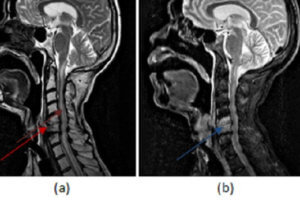Herpes zoster oticus, or Ramsay Hunt Syndrome, is a polyneuropathy secondary to reactivation of latent varicella zoster virus in and around the ear.
Clinical features of Ramsay Hunt Syndrome
- Ear pain
- Vesicles followed by an erythematous vesicular rash over the external ear/auditory canal
- Ipsilateral facial paralysis (loss of the nasolabial fold, dropping of the corner of the mouth, inability to close the eye on the affected side)
- Vertigo, tinnitus
- Symptoms referable to CN V, IX, and X can also be present
Etiology of herpes zoster oticus
Ramsay Hunt syndrome is due to activation of latent varicella zoster virus (VZV) residing within the geniculate ganglion (CN VII). The inflammatory process however can spread to involve other cranial nerves like CN V, VIII, IX, and X.
Diagnosis of Ramsay Hunt
Diagnosis can be difficult as many patients will initially present only with facial paralysis. At this stage, the symptoms may be wrongly attributed to Bell’s palsy. Ear pain, if present in addition to facial paralysis, supports the diagnosis of VZV reactivation. A careful examination of the external auditory canal for vesicular lesions is prudent. Use of VZV titers in blood or isolation of VZV DNA thru PCR from ear scrapings have been used in studies but are not usually used in clinical practice.
Since treatment of Bell’s palsy and Ramsay Hunt Syndrome (see treatment below) is quite similar, an absolute distinction between the two is not always necessary.
Differential diagnosis of Ramsay Hunt Syndrome
- Bell’s Palsy (CN VII motor neuropathy which is usually idiopathic)
- Central lesions like stroke can be differentiated from peripheral lesions like bell’s palsy and herpes zoster oticus by preservation of the forehead muscle strength in central lesions
Treatment of herpes zoster oticus
Corticosteroids (prednisone) and antivirals (acyclovir) remain the mainstay of treatment. Though there are no randomized controlled trials, case reports and retrospective studies show improved outcomes in patients treated with prednisone and acyclovir. Treatment is most effective if started within 3 days of onset of symptoms, though there is still efficacy even if medications are initiated up to 7 days after onset.
Eye lubrication with drops and ointment should also be recommended till the facial paralysis resolves.
References
- Gilden, D H, M.D. Ramsay Hunt Syndrome. J Neurol Neurosurg Psychiatry 2001;71:149-154.
- Albrecht, Mary, M.D. Clinical manifestations of varicella-zoster virus infection. Uptodate.com.

